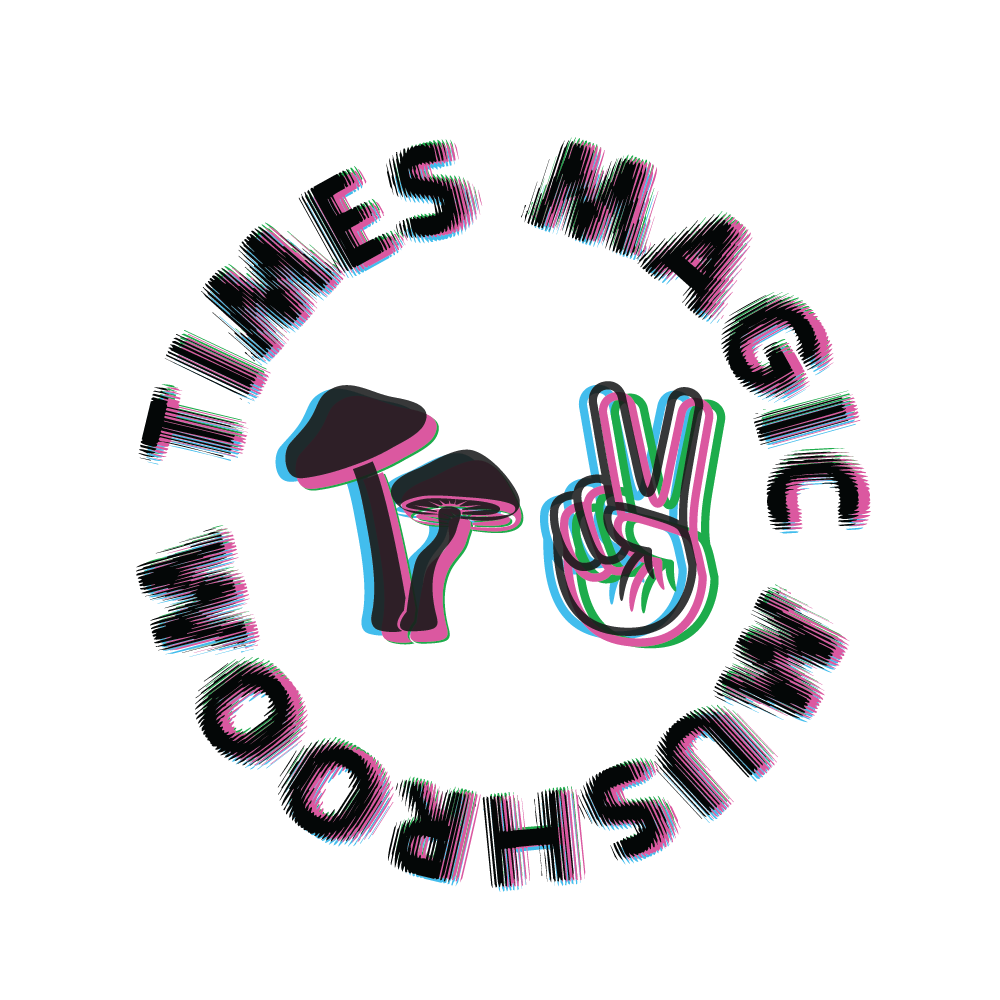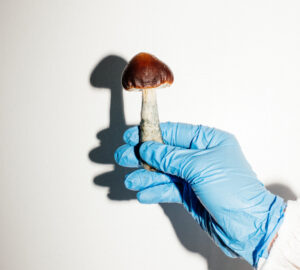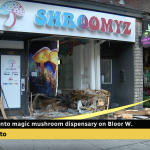This story begins with a funeral. On my 33rd birthday in June, I entered my coffin on five grams of mushrooms, had it “nailed” shut, and listened while sixteen friends delivered eulogies as the soundtrack to my trip. My heart was broken and I sought a new one. Drawing inspiration from Greek mythology, I embarked on katabasis—a descent into the underworld where one experiences a loss of self that “strikes us to the core,” to use the words of Sylvia Brinton Perera in Descent to the Goddess—and where we confront what Jung calls our Shadow, the repressed aspects of self that reveal our buried potential. This process is followed by anabasis or a “going up,” once we’ve integrated what we discovered within ourselves and brought this wisdom back into our communities. The idea is that the distinct intensity of ritual protects us from self-harm in the physical realm through symbolic self-destruction—as Odin hung from Yggdrasil. At the very moment of metamorphosis, we experience death as impermanence by voyaging into chthonic darkness and returning to the roots of esoteric knowledge.
The practice of “dying before dying” has historical significance. As suggested in Brian Muraresku’s book, The Immortality Key: The Secret History of the Religion with No Name, our ancestors’ consumption of psychedelics might have been used to engender near-death experiences, leading to spiritual insights. Can it be said that a peak mystical experience is “training for death?” In many ways, it mirrors the archetypal journeys that reshape the essence of one’s being.
“At death, we ourselves will be involuntarily expanded. We will suddenly be the river and the late summer wheat field and the distant sky of stars. It sounds beautiful, but also terrifying. Will the vastness terrify us? Maybe not. If we’ve practiced an embodied vastness, what would that feel like?” asks Josh Schrei, host of The Emerald podcast.
Anxiety about death is not a universal, ontological truth but a pervasive feeling in our culture as a result of our alienation from nature and the denial of our own right to graceful decay. “Having moved away from paganism into modern society, we moved into states of fear of death. Which is, in essence, the fear of nature,” says Sigourney Belle Weldon, death doula and founder of Death School, a year-long program that helps people find wisdom in mortality by giving them experiences of death through psychedelics. “Nature never completes. There’s decay and rebirth, and it’s the same for the human form and the spirit. What we fear is the process.”
D.H. Lawrence called death “the last wonder.” In a small study from the University of Michigan, researchers detected heightened gamma wave activity, typically associated with conscious thought, in the brains of patients moments before death. This surge in brain activity, which in one instance peaked at three hundred times normal levels, was documented in the Proceedings of the National Academy of Sciences. The findings not only challenge the notion of diminishing consciousness as death nears but also corroborate descriptions of “near-death experiences” (NDEs), a term first coined by philosopher and psychiatrist Raymond Moody.
Frequently reported aspects of NDEs include bright lights or moving through a dark tunnel, mystical encounters, experiencing an alternate realm, a sense of unity with the universe, and out-of-body sensations. It’s worth noting that all classic psychedelics—psilocybin, LSD, mescaline, and DMT—appear to induce experiences like this, too.
Death is unavoidable, so the most rational response is to accept it and live one’s life in preparation, says philosopher Michel de Montaigne. Weldon believes that people resist death when they’re denying their true path in life, instead, distracting themselves with the notion that they’ll do what they’re meant to—one day. She suggests remediating potential regret by meditating on death. If you only had one week left, who would you call to say “I love you?” Who would you want to thank? What’s incomplete? That way, “at the time of death, there’s less to unravel,” she says. “Close loops as you live.”
Death walker, medicine man, and Death School co-facilitator, Joel Camp, who has been pronounced dead seven times and once flatlined for 11 minutes as a premature baby, has facilitated psychedelic experiences for hundreds of people, allowing them to confront and embrace parts of themselves they dislike while allowing others parts to metaphorically die. Camp focuses on supporting people grappling with suicidal ideation by helping them conduct a symbolic funeral process with their families and loved ones. “Hopefully, as a way of preventing someone from taking their own life,” he says, “but in the case that they do, it’s a way to allow closure on all sides.”
Each human life is comprised of “little deaths”—experiences that drastically alter our perception of who we are. In ritual-starved modernity, initiations are often superficial and devoid of enduring resonance (think: alcohol-fuelled New Year celebrations and bachelor parties, pristine baby showers, or even funerals where we wait until someone is dead to share the impact they had). Where’s the honesty? There’s a lack of communal witnessing of the body’s spiritual significance through the ages, from birth to puberty, maiden to motherhood, menopause, aging, and death —and a loss of the wisdom that comes with rites of passage, which often involve an “identity crisis” that recalls the chaos of the unknown, followed by the euphoria of a metaphorical revival. Without intentionality, life becomes a performance that provokes miscarriages of meaning: tragic acts and ghostly wanderings of lives half-lived.
When viewed through a lens of initiation, even substance dependence can be seen as a misdirected quest for transcendence, says Michael Meade in Rites and Symbols of Initiation. The incessant drama of inner torment signifies a deep yearning for spiritual relief. However, if rites are respected as a connection to our ancestral past, and a process emphasizing our cyclical nature—creation, annihilation, and rebirth— they can significantly benefit how we experience challenging transitions. In the resurgence of psychedelic research, we are presented with a counter-narrative to death denialism and an opportunity to re-introduce rituals that bridge life and death–whether literal or symbolic. “We step outside of a selfbuilt prison of rules, boundaries, order, and distinction into a place of void,” says Camp on using psychedelics to prepare for death, “and from that place of chaos, we understand that there is no life and no death. It’s just a sliding scale that we exist upon, and we get to witness ourselves move from one end to the other in this beautiful dance.”
Gotthold Ephraim Lessing’s 1769 discourse, How the Ancients Represented Death, contests the portrayal of death as an ominous hooded figure carrying a scythe, reminding us that death was once personified as an elegant youth, poised with crossed feet, holding an extinguished torch. “I picture a skeleton walking through the woods holding a colorful bouquet of mushrooms,” says death doula Caroline Lee. “Mushrooms have reinforced to me that our bodies, in their natural wisdom, know exactly how to navigate the process of dying, but it’s our minds and ego, with its focus on legacies and making a mark, that gets in the way.”
The prevailing theme in both the “Iliad” and “The Odyssey” is that death is the shared fate of all people. Death does not merely end life but tells life’s story. “I’m pregnant,” says Lee, recounting how surreal it was to hold her 80-year-old housemate’s hand as she transitioned into death while feeling a baby moving inside her. Perhaps, death is not the opposite of life, but of birth. “There’s much more of a mystery and a cosmic dance to death than it is some dark, depressing thing.”
Sarah Tarlow, a professor of historical archaeology at the University of Leicester, best knownfor her work on death and burial, describes her partner Mark’s decision to end his life—following a bitter, drawn-out, and undiagnosed illness—as an act of “courage and love.” Her new book, The Archeology of Loss, explores the myriad of emotions beyond grief that are tied to death: anger, exhaustion, and even relief. It’s as much a personal excavation of meaning as it is a damning commentary on existing legal systems surrounding assisted death. “He did it without telling me to protect me from the law,” she reveals. “He died on his own, but I can’t imagine that he wouldn’t have wanted me to be there holding his hand.”
Tarlow points out how society often views death as a failure of medicine. This narrative that something has gone wrong if you die, she says, reflects our collective inability to integrate death into the natural arc of life. But as she rightly points out, “Everybody dies.” Tarlow advocates for complete autonomy and customization of when and how one chooses to die. “When I gave birth, I had specialists guiding me, informing me of what to expect through out the process and trying to accommodate my requests,” she says. Why is this level of attention notably absent from the process of dying?
In ancient cultures, a transition to the afterlife was overseen by “psychopomps,” originating from the Greek words “psyche,” meaning soul, and “pompos,” meaning guide. From Hermes, Charon, and Thanatos in Greek mythology, the jackal-headed Anubis in Egyptian tales, and Shinigami in Japanese folklore, these divine entities shepherded souls through the complexities of realms beyond physical existence. In our contemporary world, this ancient concept finds renewed purpose in the rise of professional death doulas or end-of-life doulas (EOLDs), who provide non-medical, practical assistance and spiritual care to individuals nearing the end of life. The National End-of Life Doula Alliance grew to more than 1,000 members in 2021 (from just 200 in 2019), and some training groups, such as the University of Vermont’s end-of-life doula program, saw enrollment triple during the pandemic–a multi-year ordeal when news of people dying was unavoidable.
A paradigm can be understood as the grid of assumptions and perceptions that shape how the majority perceive reality. In Ernest Becker’s Pulitzer Prize-winning book, The Denial of Death, he posits that “normality is the refusal of reality.” This perspective aligns with the notion that societal-influenced perceptions are frequently used as buffers to neglect fundamental truths of existence. The fact that we fear death is a denial of reality, and that denial is stopping us from dying the way we want to. We need a paradigm shift in our acknowledgment of death as a process to be regarded with care—not something to be demonized or ignored.
The over-medicalization of death in the Western world began in the mid-20th century with a shift to hospital-based, end-of-life care that transformed the experience of death from a deeply personal, community-based event into the default mode of medicine, which emphasizes preserving life at all costs. “We no longer keep the deceased in our homes, and it has become a burden rather than a blessing to hold our old people,” says Camp.
The early days of Dr. Shoshana Ungerleider’s medical practice were riddled with moments of despair as she tended to frail, elderly patients, often isolated and in pain. It prompted her to ask: If given the choice, would these patients have chosen this for their final moments? She founded End Well in 2017 to facilitate dignified, human-centered conversations about what matters most to people in their final days, weeks, or months. “While we save lives every day in our ICU, there are many people for whom aggressive and invasive treatments at end-of-life merely prolong suffering without adding meaningful quality,” she says. Echoing the sentiments of countless healthcare professionals, she believes in shifting this narrative. But it’s not just about changing hospital practices. Her advocacy for increased research and dialogue around psychedelic-assisted therapy stems from its potential to alleviate the existential distress felt by those nearing life’s end. Ungerleider says that as a society, “we owe it to humanity to investigate this further” as a solution that prioritizes patients’ emotional well-being “and allows people to live fully until they die.”
Dr. William (Bill) Richards, a psychedelic research pioneer, has advocated for this his whole professional life. During the first wave of psychedelic research in the 50s and 60s, he participated in clinical trials that showed the promise of psychedelics for distress associated with dying. And in 1999, he and Dr. Roland Griffiths, also regarded as a pioneer in psychedelic science, launched the rebirth of psilocybin research after a 22-year period of dormancy in the United States. When Richards’ whole department was eliminated in 1977, he remembers emptying his office and thinking that was the end of psychedelic research. Now in his eighties, he has a mischievous gleam in his eye when we speak over Zoom. He is the Chief Therapist for Sunstone Therapies, where he is paving the way for integrating psilocybin therapy into palliative care in oncology centers.
“You see someone go from lying in the bedroom with their drapes closed waiting for the next dose of pain medication, depressed, anxious, hiding from other people and fearful of death, to being in the present and enjoying friends with a sense that ultimately all is well—and wasn’t it great to have what the Buddha called ‘one precious human life.’ There’s gratitude instead of fear,” says Richards, describing a common psychological shift witnessed among the many people he’s held through psychedelic journeys as they neared the end of their lives. Reflecting on the experiences of participants at Sunstone, especially those in group sessions with other cancer patients, he highlights the unexpected strength of group dynamics. “When a cancer patient discovers that he or she has the power to be helpful and supportive to other cancer patients, it becomes a community, a secret society,” and humorously adds, “They almost say, ‘I don’t know which of us is going to die next, but I’m off to Europe!” What if psychedelic-assisted therapy for end-of-life distress goes mainstream and oncology centers start offering it to anyone approaching “the adventure of death?” asks Richards. “That could change the baseline of consciousness. What would the world be like?”
Transcendent states of consciousness invite us to surrender by stripping away our illusions of control and awakening us from the routines of everyday life into the miracle of existence. The mundane becomes extraordinary. Austrian psychoanalyst Otto Rank believes in “the need for legitimate foolishness” to wake us from normality. To accept death, we must go mad. Death misses laughter. It misses our music; stomping feet; our grief and relief as song, ritual, and rapture. Death misses dancing. Sometimes, that dance looks like a fight; “do not go gentle into that good night,” writes the poet Dylan Thomas.
How might we re-introduce ritual in a modern context to give our little deaths more weight and literal death some levity? In our dance with death, life is the music; “so get out there and dance,” says Richards. Asked about his own relationship with mortality after sixty years of psychedelic research, he simply says: I put the daffodils and tulips in the ground in the fall and I hope to see them in the spring.
“Your body is not a coffin for pain to be buried in,” writes Nigerian artist Ehime Ora. When my funeral was over, I bowed to my community as witness, surrounded by torches of flickering flame, feeling like a baby newly emerged from my tomb, the womb of the world. I saw questions in their eyes as if I were a traveler who had wandered somewhere beyond reach.
For three months afterward, I immersed myself in private contemplation. However, one cannot get stuck in the muck of healing in solitude but must return to the land of the living with the courage to create, and relate, again. So, in the pregnant heat of an August afternoon in the Canadian wilderness, like a baptism, I was dipped in a calm, dark lake and surfaced with my new, shiny heart beating. The ritual was complete. The loop was closed. I didn’t have the words on the day of my funeral, but I do now, and I lay them here in your hands as my offering. When your heart aches, when you wake to the fragile beauty of the body and the astonishing resilience of the human spirit, when you speak to your children and the trees, are struck by the poetry of melting snow: notice the graying of your hair, shake with laughter at the threshold of love, do your laundry, make music of your sorrow, make art with your life, and meet the staggering light; one day, we will all feed the earth with our bodies, but until then: don’t lose hope.
If you’re looking for peer support during or after a psychedelic experience, contact Fireside Project by calling or texting 6-2FIRESIDE. Interested in having a psychedelic experience, but don’t know where to start? Get our definitive guide on trusted legal retreat centers, clinical trials, therapists, and more.
DoubleBlind Mag Read More



